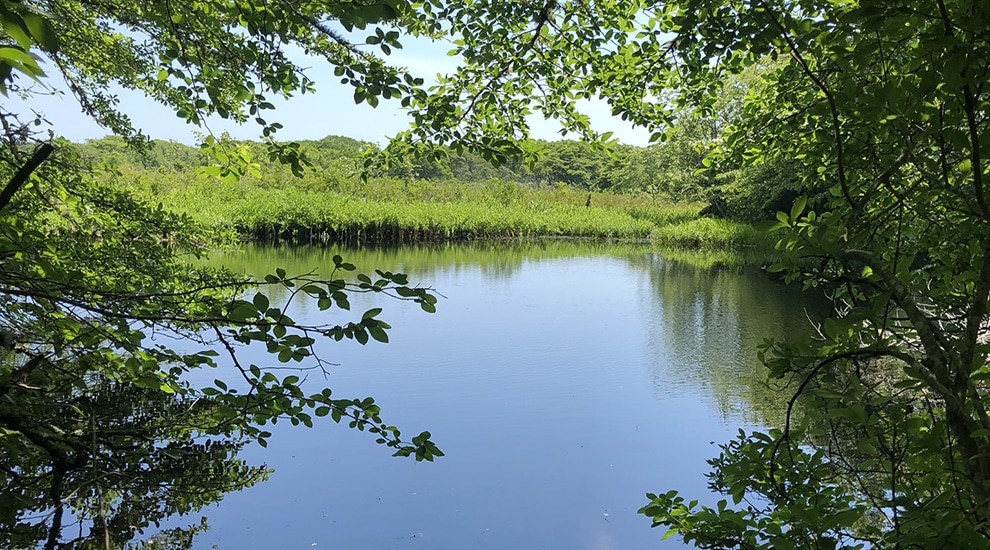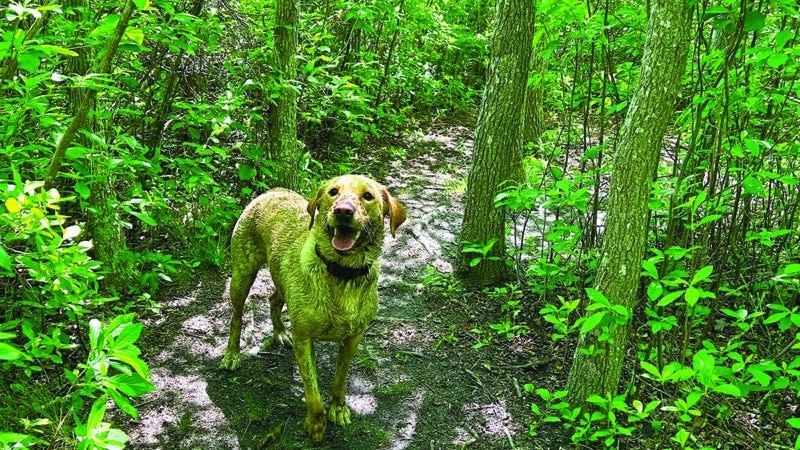NANTUCKET TRAILS: STUMP POND
by Dr. Sarah Treanor Bois, PhD
Director of Research & Education at the Linda Loring Nature Foundation
Living on the island year-round, we have to mix up our walking and hiking trails. I have two dogs that need exercise (and love water). I can easily get in a rut and rotate through the same three or four trails every week. Over the past years, I have made an effort to try new trails (or trails that are new to me) or to return to areas I thought I knew but haven’t visited in a while. With more than 9,000 acres under protection as open space, we are lucky to have so many trails on Nantucket to choose from!
One trail I was rewarded with rediscovering is the trail system around Stump Pond. I’ve been familiar with Stump Pond itself for a long time. Now a stable, amoeba-shaped pond, it was once the feeder pond for Windswept Bogs when the cranberry bogs were in active production. The Windswept Bogs themselves are right along Polpis Road and are a pretty popular walking spot. The Nantucket Conservation Foundation, which owns the bogs, is working on a huge restoration project for the area which will restore wetland flow, among other goals. The public can access Stump Pond trails via the Windswept parking lot on Polpis Road, but I recently discovered the Almanac Pond Road entrance to the trails that the Nantucket Land Bank (NLB) maintains. This access point is a little quieter: a rarity on-island during August.

The Stump Pond loop trail that I take covers property jointly owned by the Land Bank and the Nantucket Conservation Foundation (NCF). To get to the trail from the Milestone Rotary, drive east on Milestone Road for 0.3 miles before turning left onto Polpis Road. Continue on Polpis Road for 4.3 miles, then turn right onto Almanack Pond Road. Continue on Almanack Pond Road for 0.8 miles, and the dirt parking lot is on the right. The entrance to the Stump Pond trails is across the road from where you will park. The trail entrance is marked by a new Nantucket Land Bank Sign for “Stump Pond Reserve,” which highlights proper trail use (please read it before you set out).
The single-track trail starts off from there in the red maple and tupelo swamp woodland. There are boardwalks over the wet areas. These boardwalks are great, but it was hysterical to me when my dog was afraid to traverse it. She behaved like she thought there was a troll beneath! Boardwalks like these keep your feet dry, but they also protect the path from too much foot traffic. This wet understory is full of flora and fauna that we don’t want to trample. Wetlands are especially vulnerable to foot traffic. Cinnamon ferns line either side of the board walks giving a Jurassic Park vibe. This time of year the area can be a tad buggy (it is a pond surrounded by marsh), but walking in a forested landscape is a reprieve from the hot summer sun these dog days of summer.
The forest trail meanders along the south part of Stump Pond, only intersecting with the pond in a few spots. The hardwood forest surrounding Stump Pond contains some very old trees, including several American beeches and American hollies that are at least a century old. Examples of other tree species found on the property include black tupelo, shadbush, black and white oak, mockernut hickory, and sassafras.
The rolling trail has some topography, and there are some good vista points. There are overlooks of Stump Pond itself and other high points. Using the ACKTrails app, you can follow the Stump Pond trail loop and read the highlights along the trail.
Stump Pond itself was created in the early 1900s for the cranberry production at Windswept Bog. The area that is now the pond was once a red maple swamp. The swamp was clear-cut in order to channel the flow of water. The pond got its name because when the water was low (i.e. when the water was diverted to the bogs) the stumps of the old trees were visible.
Since the Nantucket Conservation Foundation halted bog production, the water level in Stump Pond has remained stable and the stumps generally aren’t visible. The lack of precipitation of late has caused the water to draw down a bit making some stumps visible.
According to the Nantucket Conservation Foundation website: “Pockets of red maple swamp occur throughout the hardwood forest in low lying areas containing standing water. Growing below the tree canopy and forming another vertical layer in the forest are shrubs such as highbush blueberry, northern arrowwood, swamp azalea, and sheep laurel. Below these is a third layer of flowering plants and ferns, including wintergreen, whorled loosestrife, trailing arbutus and cinnamon fern.”
The Stump Pond trails are a bit off the beaten path, which is great when you want to be alone with your thoughts or listen to a podcast and not be bothered by others. Over the past several months, I have travelled the Stump Pond trail many times, and I only ever see a handful of people and dogs and some bikers.
If you want to further extend your adventure in this area, you have many options. You can walk further in and around the Windswept Bogs themselves. Alternatively, you can add on the Norwood Farm property. Norwood Farm is the result of a joint purchase of 207 acres between the Nantucket Land Bank and the Nantucket Conservation Foundation. The property consists of hills and valleys formed by terminal moraine deposits during the last glaciation. Most of the lowlying areas are wetlands, which are isolated or connected by intermittent streams. The property is located on the northern edge of over 6,700 acres making up the Middle Moors. With all of this land and trail connection, there are endless possibilities for continuing your Nantucket hiking adventure.
Peter Brace of Nantucket Walkabouts offers expertly guided hikes of Stump Swamp and Norwood Farm. During August, he is offering morning and afternoon tours of this area of the island. To book this hike (or one of the nearly dozen others he guides), go to WalkNantucket.com



